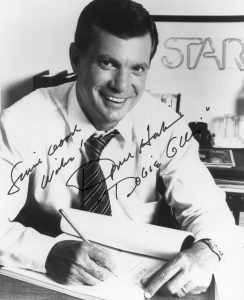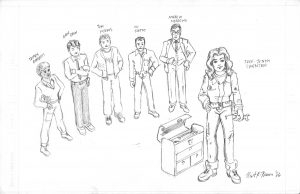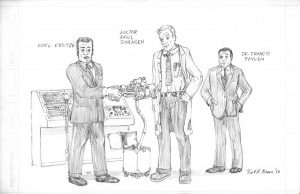Dwayne Hickman 1934-2022
The news that Dwayne Hickman passed at age 87 affected me quite a bit. Mr. Hickman is a noted actor who became well known as Dobie in The Many Loves Of Dobie Gillis. Which was an early TV show success. For me, Mr. Hickman was associated with a comic project that myself and close friend Jack Morelli, created.
I don’t like to write about Spitfire And The Troubleshooters. The bare bones of the story are just about what I can think about without spinning off into frothing unpleasantness. But for the sake of telling this delightful detail, I will do what I can.
The basics: I worked at Marvel for a long time at that point—so did Jack! During most of 1985 I was termed Special Projects Editor. I asked for and got Jack Morelli as my Assistant. The word “Editor” didn’t quite mean what it sounded like as myself and Jack did not edit comics as such. We did everything else from Band-Aids™ to national ads.
Fall, 1985, Marvel Comics Editorial Offices, 387 Park Avenue South, NYC. The PowerPoint slide says Eliot Brown and Jack Morelli are sitting in a meeting about the New Universe. If you don’t know, at Marvel the New Universe was a – and here I paraphrase – a different direction for comics to take. At some point, Spitfire And The Troubleshooters is born. Soon, quite soon, Jack and I are made the newest Editorial team and dedicated to 4 of the New Uni titles. Plus writing Spitfire.
I lived on 66th Street and Jack lived on 54th—all on the East Side—we often had meals together. Up by me was the ideal place to prepare for a cold winter, Swensen’s Ice Cream Parlor.
By night we both watched as much TV as possible. The CBN (Christian Broadcasting Network) being the cable-TV watering hole for ancient shows… like Mission: Impossible, The Man From U.N.C.L.E. and The Many Loves of Dobie Gillis… !
I was old enough to have caught a couple Gillises the first time around. Loved them as a kid. Enjoy them more and still as an aging person. Jack too, with his inner Ancient One laughing as hard as me. If you don’t know the show, it’s never been easier to see it. The show was all about a love torn youth, Dobie, and his pursuit of girls and women. The show represented, to quote Mr. Hickman, “–the end of innocence of the 1950s before the oncoming 1960s revolution.” Which might explain its lasting appeal.
The Dawn of Television was still twinkling just before Dobie. When I say ‘dawn’ I ain’t kiddin’. Television was put on hold during WWII but came jumping out of the box right after. Some of this Golden Age stuff is astonishing as it was created live. For you young’uns out there, it was a Live Stream run through a monstrous and cranky creative machine. Television. It was ‘live’ because there were very few ways to record these shows. Many of those early shows are lost because of that. Those that are not look like a weird movie because it was made by pointing a motion picture camera at a high resolution TV screen (kinescope or telecine chain). The same problem existed which was, no edits. No second takes.
An interesting technical note (hope you’re sitting) is that there was a huge network of filmmakers and all the support mechanisms needed to make movies just sitting around. I believe it was Lucille Ball (1911-89) who was a part of the decision-making process to shoot her show (I Love Lucy, 1951-1957) using three movie cameras. There was already such a process developed by a documentary filmmaker, Jerry Fairbanks and used in an early game show. It allowed for film saving by only activating one camera at a time by recording a master sound track to allow synchronizing the images later. This 3-camera idea was developed by Legendary Cinematographer Karl Freund (1890-1969) who started young in the fertile field of German cinema, finally shooting Metropolis (UFA, 1927) before seeking his fortune in America, and then Dracula (1930).
This is the reason that we have a wealth of this early TV. Big, beautiful 35mm film versions of early TV.
The Many Loves of Dobie Gillis—the writer Max Shulman had success as a TV creator with earlier versions of his books turned into TV shows, including Dobie. That seemed like a great premise that allowed for an ensemble cast to inhabit a few standing sets and the show was launched. When it came time to generate names for the characters, Jack and I drew from the world around us. Jenny Swensen and of course her pop, came from the eatery. “Jenny” was from Weill & Brecht’s Three Penny Opera “The Pirate Jenny.” A bad guy was named Frank Faylen—after the real name of the actor who played Dobie’s dad. The antagonist– evil, giant military corporation was named after innovative and remarkable, maverick Japanese plastic model kit maker Nitto. Kröte (which we changed to Krotzë to avoid being sued…) was a model of a man-carrying armored robot. A whole line of super cool and still wild designs called SF3D. Look ‘em up.
Never-before-seen and also should-not-be-displayed primordial artwork by myself. Back in 1986 I had not drawn “people” as such. That is clearly demonstrated here. But I felt I should try to communicate some ideas to series’ artist Herb Trimpe. Which Herb encouraged, so I blame him for my hubris. Jack and I drew from the world around us—including inserting us into Spitfire. Anyone who knows us would recognize Jack and myself (with my fuller head of hair!). Eric Chin was based on a High School chum of mine, Ferris looks a heck of lot like Andy Rakowski—a friend of the Bullpen back in those days. Roberts was based on a good friend from my architecture department days at City College. Jenny? Looked a lot like Anne Nocenti. Not sure that’s what I was trying for but Herb spotted it.
One fine day, Jack slides his newspaper to me and points to a news squib. It said that Dwayne Hickman was now some kind of CBS-TV executive, a Producer. CBS-TV, Channel 2 in New York City, was right across town! Feeling the giddy, power-mad creator/editorial tremor washing over me, I picked up the office phone and dialed “Operator.” I asked the speedily efficient person for CBS Television and before you could say, “Work!” I was speaking to an intelligent front desk lady who informed me that Mr. Hickman was in the Los Angeles offices. That piece of information was not in the newspaper article. But I merely wanted to leave a message of appreciation and said so.
To my lasting consternation, that lovely person calmly informed me that she could “connect” me to his office. That was late 1985, the idea of a transcontinental phone connection was not new or strange to me. What was shocking was that any rube off the street would be treated to such a wonder.
I sputtered something about “no special treatment” … “just leave a message” and gulping hard at the image of coolly coifed secretaries pushing sleek buttons… before I knew it, another velvety smooth voice was answering, “Dwayne Hickman’s office—“
I laid out my bona fides as Marvel Comics Editor and that I wished to thank Mr. Hickman, etc. This mistress of gentle let-downs informed me that Mr. Hickman was very busy—
But then… a change in tempo and the news that Mr. Hickman would be happy to talk to me. Four seconds later, the familiar still-boyish tones of Mr. Dwayne Hickman said, “Hello.”
Deep breath time… hold on to the edge of the desk with my free hand… and… I started by saying he was very nice to take a call from a fan. I gave him a quick summary of what Jack and I were doing with Spitfire, how much we admired the show and work he had done. That Jack and I were using as many names as we could, such as Mr. Frank Faylen’s.
Can’t quite place Krotzë, but that is Max Von Sydow as Paul Swensen (first name from Christy Scheele’s tall, aristocratic father) and Francis Faylen (trying to be formal there…) who looks quite a bit like actor David Doyle.
[A pause here for Frank Faylen (1905-85). Anyone who was a kid in the 70s or 80s, knows a tribute to him already. Faylen and fellow actor Ward Bond (1903-60) had been “day players” at Warner Brothers Studios for years. When it came time for Director Frank Capra (1897-1991) to cast It’s A Wonderful Life— (1947, Liberty Films released by RKO) he chose two of the finest character actors around for the parts of a cab driver and a cop. Their names? Bert and Ernie. In 1969 those names were given to a couple of Muppets made for Sesame Street. Jim Henson (1936-90) most likely was influenced by that mellifluous pair of names.
If that’s not enough hiking down Memory Lane—The Many Loves of Dobie Gillis was a heavy inspiration for Scoobie-Doo—Where Are You! and Happy Days.]
I remember him asking where we watched the show. I informed him it was running every night on the CBN and that Jack and I watched as often as we could. Mr. Hickman modestly maintained that he was very lucky to be working with so many good actors around him. He mentioned that the writers for the show got their experience writing for actor/comedian Jack Benny (1894-1974) on radio.
I mentioned that Jack and I particularly appreciated Mr. Faylen, in fact, all his work as a character actor.
Frank Faylen had passed earlier that year, so there was a catch in Mr. Hickman’s voice as he praised Mr. Faylen. I believe he again mentioned that a part of his good fortune was working alongside of such good and experienced actors.
I asked about doing a new Dobie project and he answered that Mr. Denver, who played beatnik Maynard G. Krebs (Bob Denver (1935-2005) now much better known for starring in Gilligan’s Island) didn’t seem interested. [I must note that a short 3 years later, Bring Me The Head of Dobie Gillis hit the airwaves!] I expressed my hope for a future show.
When I asked Mr. Hickman if there was anything he was doing—and I believe I used that language—Mr. Hickman mentioned that he was just working hard every day at that current job. So I may have jogged an elbow about him finding his place in the executive suite. What I’d meant was any other acting gigs.
At that point it was time to ring off. He gracefully pardoned himself and I wished him well. That is the end of the story. If given a bit more time, I know Jack and I would have used many more names of the actors from Gillis. First or last names, tucked here and there as tips o’ the hat to the creators of yore… Florida Friebus, William Schallert, Jean Byron, Ray Bailey, Sheila James, Tuesday Weld… but that was not to be.



Brilliant writing!
You are too kind and I thank you.